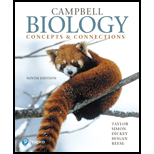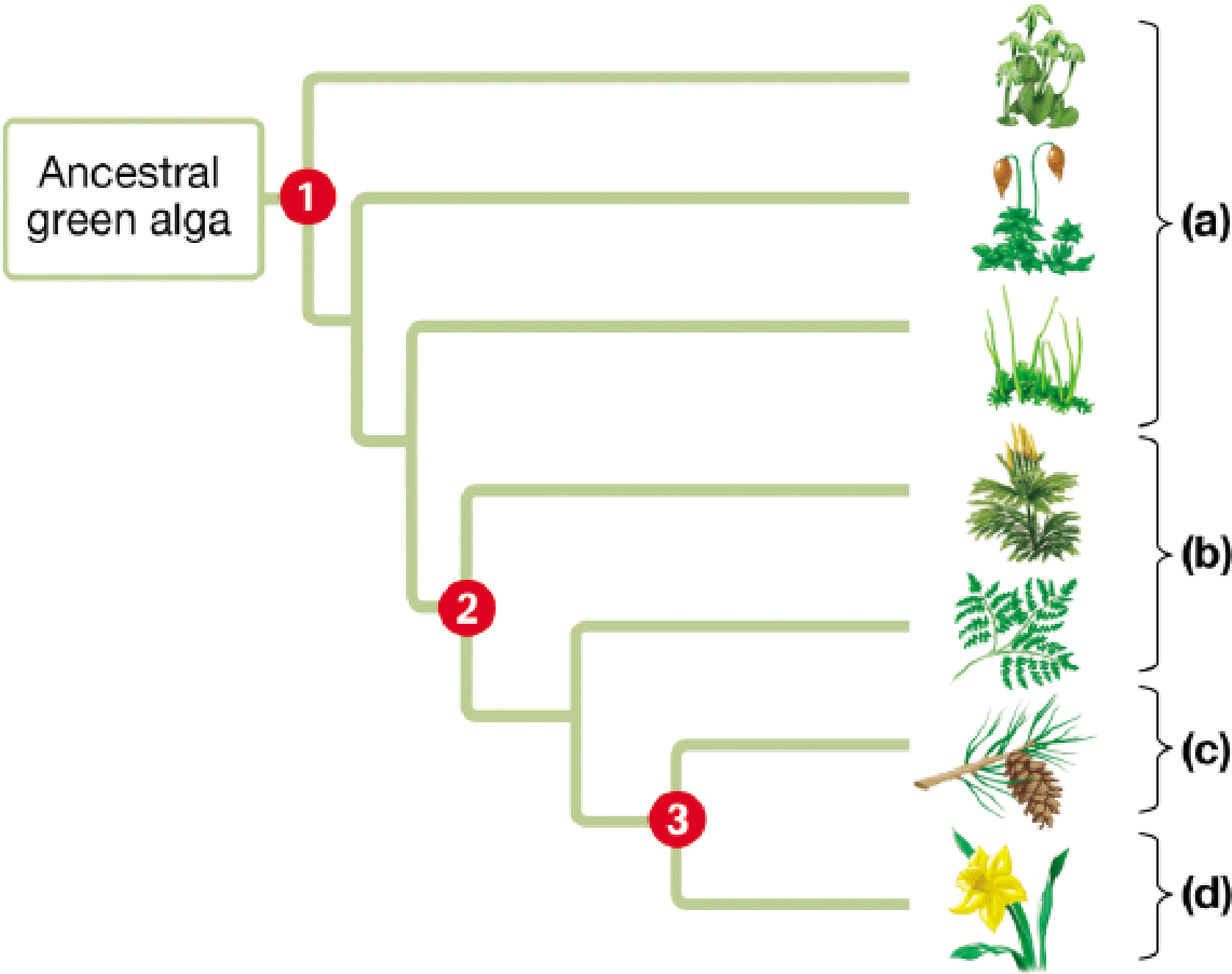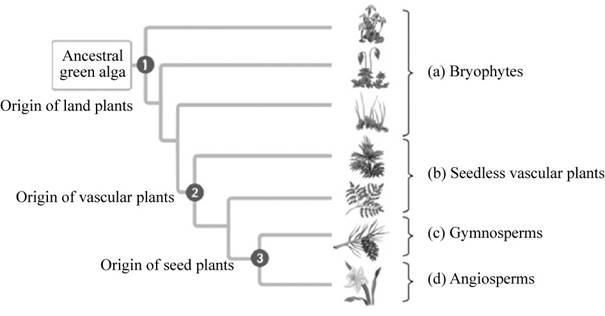
Concept explainers
In this abbreviated diagram, identify the four major plant groups and the key terrestrial adaptation associated with each of the three major branch points.

To determine: The four major plant group and their key terrestrial adaptation associated with each of the three major branch points.
Introduction:
The evolution of plants started with the origin of land plants that included the bryophytes. Land plants developed apical meristem and the embryos. After the land plants, the origin of vascular plants occurred. They involved the seedless fern and mosses. Lastly, the origin of seeded plants occurred. This includes the angiosperms and the gymnosperms.
Answer to Problem 1CC
Pictorial representation: The highlights of plant evolution are depicted in Fig.1.

Fig.1: The major events in plant evolution.
Explanation of Solution
The three distinct adaptations which gave rise to the four major plant groups are:
(1)
Correct answer: The origin of land plants.
Explanation:
The first terrestrial adaptation includes the origin of land plants. Their development included presence of the meristem and the embryos within the parent.
They include the major plant group (a) the bryophytes. The bryophytes are the non vascular plants and they evolved from the green algae about 475 million years ago. It included the development of apical meristem and embryos. For example: Mosses, hornworts, and liverworts. Hence, the correct answer is origin of land plants.
(2)
Correct answer: The origin of vascular plants.
Explanation:
The second adaptation includes the origin of vascular plants. It included the development of vascular tissues that helped the plants to grow tall and move away from the moist environment. They were now able to transport water to the leaves from the roots.
They include plant group (b) the seedless vascular plants. They evolved about 425 million years ago and include the ferns, club mosses and the horsetails. Hence, the correct answer is origin of vascular plants.
(3)
Correct answer: The origin of seed plants.
Explanation:
The third adaptation includes the origin of seed plants. They included the vascular seed plants. The seeds provided protection and dispersion of the embryos.
They include two major groups of plants:
Group (c) Gymnosperms: They include the seeded plants which have their seeds within the cones. They evolved about 360 million years ago. For example: pines, fir and spruce.
Group (d) Angiosperms: They include the vascular seeded plants that bear flowers. They evolved about 360 million years ago along with the gymnosperms. For example: rose, maple trees and oak trees. Hence, the correct answer is origin of seed plants.
Want to see more full solutions like this?
Chapter 17 Solutions
Campbell Biology: Concepts & Connections (9th Edition)
- What type of structure(s) would you expect to see in peripheral membrane proteins? (mark all that apply) A. Amphipathic alpha helix (one side is hydrophilic and one side is hydrophobic) B. A hydrophobic beta barrel C. A hydrophobic alpha helix D. A chemical group attached to the protein that can anchor it to the membranearrow_forwardTemporal flexibility (the ability to change over time) of actin structures within a cell is maintained by… A. The growth/shrinkage cycle B. Periodic catastrophe C. GTP hydrolysis D. Treadmilling E. None of the abovearrow_forwardDuring in vitro polymerization of actin and microtubule filaments from their subunits, what causes the initial delay in filament growth? A.Nucleation B.Reaching homeostasis C.Nucleotide exchange D.ATP or GTP hydrolysis E.Treadmillingarrow_forward
- You expect to find which of the following in the Microtubule Organizing Center (MTOC)...(mark all that apply) A. Gamma tubulin B. XMAP215 C. Centrioles D. Kinesin-13arrow_forwardThe actin-nucleating protein formin has flexible “arms” containing binding sites that help recruit subunits in order to enhance microfilament polymerization. What protein binds these sites? A.Thymosin B.Profilin C.Cofilin D.Actin E.Tropomodulinarrow_forwardWhile investigating an unidentified motor protein, you discover that it has two heads that bind to actin. Based on this information, you could confidently determine that it is NOT... (mark all that apply) A. A myosin I motor B. A dynein motor C. A myosin VI motor D. A kinesin motorarrow_forward
- You isolate the plasma membrane of cells and find that . . . A. it contains regions with different lipid compositions B. it has different lipid types on the outer and cytosolic leaflets of the membrane C. neither are possible D. A and B both occurarrow_forwardYou are studying the mobility of a transmembrane protein that contains extracellular domains, one transmembrane domain, and a large cytosolic domain. Under normal conditions, this protein is confined to a particular region of the membrane due to the cortical actin cytoskeletal network. Which of the following changes is most likely to increase mobility of this protein beyond the normal restricted region of the membrane? A. Increased temperature B. Protease cleavage of the extracellular domain of the protein C. Binding to a free-floating extracellular ligand, such as a hormone D. Protease cleavage of the cytosolic domain of the protein E. Aggregation of the protein with other transmembrane proteinsarrow_forwardTopic: Benthic invertebrates as an indicator species for climate change, mapping changes in ecosystems (Historical Analysis & GIS) What objects or events has the team chosen to analyze? How does your team wish to delineate the domain or scale in which these objects or events operate? How does that limited domain facilitate a more feasible research project? What is your understanding of their relationships to other objects and events? Are you excluding other things from consideration which may influence the phenomena you seek to understand? Examples of such exclusions might include certain air-born pollutants; a general class of water bodies near Ottawa, or measurements recorded at other months of the year; interview participants from other organizations that are involved in the development of your central topic or issue. In what ways do your research questions follow as the most appropriate and/or most practical questions (given the circumstances) to pursue to better understand…arrow_forward
- The Esp gene encodes a protein that alters the structure of the insulin receptor on osteoblasts and interferes with the binding of insulin to the receptor. A researcher created a group of osteoblasts with an Esp mutation that prevented the production of a functional Esp product (mutant). The researcher then exposed the mutant strain and a normal strain that expresses Esp to glucose and compared the levels of insulin in the blood near the osteoblasts (Figure 2). Which of the following claims is most consistent with the data shown in Figure 2 ? A Esp expression is necessary to prevent the overproduction of insulin. B Esp protein does not regulate blood-sarrow_forwardPredict the per capita rate of change (r) for a population of ruil trees in the presence of the novel symbiont when the soil moisture is 29%. The formula I am given is y= -0.00012x^2 + 0.0088x -0.1372. Do I use this formula and plug in 29 for each x variable?arrow_forwardPlease answer the following chart so I can understand how to do it.arrow_forward
 Biology (MindTap Course List)BiologyISBN:9781337392938Author:Eldra Solomon, Charles Martin, Diana W. Martin, Linda R. BergPublisher:Cengage Learning
Biology (MindTap Course List)BiologyISBN:9781337392938Author:Eldra Solomon, Charles Martin, Diana W. Martin, Linda R. BergPublisher:Cengage Learning Concepts of BiologyBiologyISBN:9781938168116Author:Samantha Fowler, Rebecca Roush, James WisePublisher:OpenStax College
Concepts of BiologyBiologyISBN:9781938168116Author:Samantha Fowler, Rebecca Roush, James WisePublisher:OpenStax College Biology: The Dynamic Science (MindTap Course List)BiologyISBN:9781305389892Author:Peter J. Russell, Paul E. Hertz, Beverly McMillanPublisher:Cengage Learning
Biology: The Dynamic Science (MindTap Course List)BiologyISBN:9781305389892Author:Peter J. Russell, Paul E. Hertz, Beverly McMillanPublisher:Cengage Learning Biology 2eBiologyISBN:9781947172517Author:Matthew Douglas, Jung Choi, Mary Ann ClarkPublisher:OpenStax
Biology 2eBiologyISBN:9781947172517Author:Matthew Douglas, Jung Choi, Mary Ann ClarkPublisher:OpenStax





